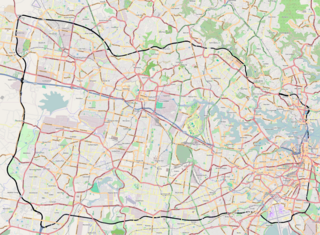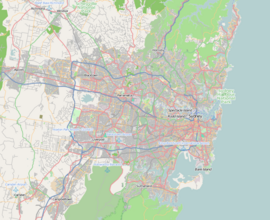
Cumberland Highway is a 34-kilometre (21 mi) long urban highway located in Sydney, New South Wales, Australia. The highway links Pacific Highway and Pacific Motorway (M1) at Pearces Corner, Wahroonga in the northeast with Hume Highway at Liverpool in the southwest. This name covers a few consecutive roads and is widely known to most drivers, but the entire allocation is also known – and signposted – by the names of its constituent parts: Pennant Hills Road, James Ruse Drive, Briens Road, Old Windsor Road, Hart Drive, Freame Street, Emert Street, Jersey Road, Betts Road, Warren Road, Smithfield Road, Palmerston Road, (New) Cambridge Street, Joseph Street and Orange Grove Road. The entire length of Cumberland Highway is designated part of route A28.

The Sydney Orbital Network is a 110 kilometre motorway standard ring road around and through Sydney, the capital of New South Wales in Australia. It runs north from Sydney Airport, underneath the CBD to the North Shore, west to the Hills District, south to Prestons and then east to connect with the airport. Much of the road is privately owned and financed by tolls.

Atlas Arteria, formerly known as Macquarie Atlas Roads, is one of the world's largest developers and operators of private toll roads.
Transurban is a road operator company that manages and develops urban toll road networks in Australia, Canada and the United States. It is listed on the Australian Securities Exchange (ASX), and is the world’s largest toll road operator.

M1 Pacific Motorway is a 127-kilometre motorway linking Sydney to Newcastle via the Central Coast and Hunter regions of New South Wales. Formerly known but still commonly referred to by both the public and the government as the F3 Freeway, Sydney–Newcastle Freeway, and Sydney–Newcastle Expressway, it is part of the AusLink road corridor between Sydney and Brisbane.

The Eastern Distributor is a 4.7-kilometre-long (2.9 mi) motorway in Sydney, New South Wales, Australia. Part of the M1 and the Sydney Orbital Network, the motorway links the Sydney central business district with the south-east and Sydney Airport. The Eastern Distributor separates Sydney's Eastern Suburbs from Sydney's Inner-Southern Suburbs. The centre-piece is a 1.7 km (1.1 mi) tunnel running from Woolloomooloo to Surry Hills. Built as a build-own-operate-transfer project, it is 75.1% owned by Transurban.

The Lane Cove Tunnel is a 3.6-kilometre (2.2 mi) twin-tunnel tollway in Sydney, New South Wales that is part of the Sydney Orbital Network. Owned by toll road operator Transurban, It connects the M2 Motorway at North Ryde with the Gore Hill Freeway at Artarmon and forms part of Sydney's M2 route, with the M2 Hills Motorway constituting the rest of the M2 route.

Pennant Hills Road is a 16.1-kilometre-long (10.0 mi) arterial road located in Sydney, New South Wales, Australia. The road links the suburb of Wahroonga in the northeast, to the major central business district of Parramatta in the southwest. Apart from a small section at its southwestern end, it is a constituent part of Cumberland Highway, and is designated part of route A28.

M2 Hills Motorway is a 19.3-kilometre (12.0 mi) tolled urban motorway in Sydney, New South Wales that is part of the Sydney Orbital Network and the National Highway west of Pennant Hills Road. Owned by toll road operator Transurban, it forms majority of Sydney's M2 route, with the Lane Cove Tunnel constituting the rest of the M2 route.

The M4 Motorway is a 55-kilometre (34 mi) series of partially-tolled dual carriageway motorways in Sydney, New South Wales designated as route M4. The M4 designation is part of the wider A4 and M4 route designation, the M4 runs parallel and/or below ground to Great Western Highway, Parramatta Road and City West Link, which are part of route A44.

The M5 Motorway is a 28.8-kilometre (17.9 mi) series of tolled motorways located in Sydney, New South Wales designated as route M5. It is part of the Sydney Orbital Network.
Sydney Bypass refers to a number of roads, existing and proposed, that motorists can use to avoid the congested approaches to the Sydney central business district (CBD). The main bypasses are:

e-TAG is a free-flow tolling electronic toll collection system used on all tollways throughout Australia. It was originally developed by Transurban for use on their CityLink tollway in the late 1990s, with the system since adopted by all toll roads, bridges and tunnels in Australia. The technology had different names depending on the issuer, such as Breeze, Linkt, and E-toll. However, these are all interchangeable across Australia and no surcharges apply for use on other operators' toll roads.
WestConnex is a 33-kilometre (21 mi) predominantly underground motorway scheme in Sydney, New South Wales, Australia. A joint project of the New South Wales and Federal governments, the motorway scheme created around 26 kilometres (16 mi) of new tunnels between Homebush and Kingsgrove, passing underneath Inner West suburbs including Haberfield and St Peters. The first of the tunnels, the M4 East, opened to traffic in July 2019. The second of the tunnels, the M8 Motorway, opened to traffic a year later in July 2020. The third of the tunnels which extend the M4 and M8 opened to traffic in January 2023. The final component of the scheme, the Rozelle Interchange, opened to traffic in November 2023.

The Light Horse Interchange is a motorway interchange located in Eastern Creek, Sydney, Australia at the junction of the M4 and M7 motorways. The interchange is the largest in Australia and was opened to traffic in December 2005. The interchange was named in honour of the Australian Light Horse Brigades of World War I, who trained at the Wallgrove Army camp that was located near the site of the interchange prior to deploying overseas.
The Sir Roden Cutler VC Memorial Interchange, often shortened to Roden Cutler Interchange and sign-posted as Cutler VC Interchange, is a three-level motorway interchange located in Prestons in South-West Sydney. The interchange forms the junction of the Westlink M7, M5 South-West and M31 Hume Motorways, opening to traffic in December 2005 along with the Westlink M7. It is a major urban feature of the National Highway network with roads linking Sydney south to Canberra and Melbourne and north to Newcastle and Brisbane converging at the interchange.
NorthConnex is a 9-kilometre (5.6 mi) twin-tube motorway tunnel in northern Sydney, New South Wales, Australia, signposted as the M11 Tunnel. It acts as a tunnel bypass of the congested Pennant Hills Road, extending or connecting the M1 Pacific Motorway to the M2 Hills Motorway. Owned by NorthWestern Roads (NWR) Group, it is one of the longest road tunnels in Australia, along with the WestConnex Tunnel. It is also the deepest road tunnel in Australia, with more than half of the tunnel 60 metres (200 ft) deep or more, and the deepest point is underneath the Sydney Metro Northwest, about 90 metres (300 ft) below ground.

The M12 Motorway, initially known as Western Sydney Airport Motorway, is an under-construction east-west motorway in Sydney, Australia, linking between the M7 Motorway and The Northern Road, as part of the Western Sydney Infrastructure Plan. The four-lane motorway is planned to be 14 km long and to be built at a cost of $1.75 billion. It is aimed at providing direct access from the M7 Westlink Motorway to the new Western Sydney Airport situated at Badgerys Creek.

Abigroup was an Australian construction company.
The M7 cycleway is a 40-kilometre-long (25 mi) shared use path for cyclists and pedestrians that is generally aligned with the Westlink M7 in Greater Western Sydney, New South Wales, Australia. The southern terminus of the cycleway is located adjacent to the Camden Valley Way at Prestons, while the northern terminus is located adjacent to the Old Windsor Road at Glenwood. The cycleway crosses the M4 motorway at Eastern Creek.
















